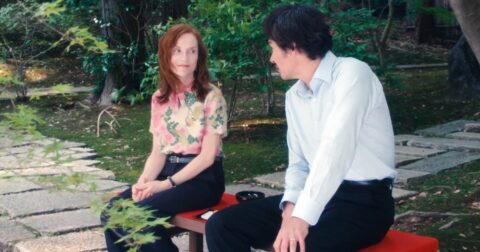Denzel Washington in The Bone Collector (Phillip Noyce, 1999). Robert De Niro in Dirty Grandpa (Dan Mazer, 2016). Jack Nicholson in Anger Management (Peter Segal, 2003). Sometimes great actors just want another house.
I hope Isabelle Huppert buys herself something nice with the paycheck for Sidonie In Japan (Élise Girard, 2023) — which sees arguably the finest, most subtle, most articulate actress of her generation phone it in with the passion of a Monday morning Teams Meeting. Actress as auteur, she can shape stories to her performances, but even the genius behind L’Avenir (Mia Hansen-Løve, 2016) and La Cérémonie (Claude Chabrol, 1995) cannot save a lacklustre script, bizarre directorial choices and an overall feeling of lethargy that permeates every frame of the inert Sidonie In Japan.
A Francophone Lost in Translation (Sofia Coppola, 2003) with an emphasis on the “lost”, it’s an adrift, off-course, absent-minded ghost story with little to say about the nature of grief, French-Japanese relations and the writing process.
Huppert stars as the eponymous Sidonie Perceval, an acclaimed writer travelling to Japan for a reprint of her first novel. While convinced to attend by the enigmatic, dour Kenzo Mizoguchi (Tsuyoshi Ihara) — no relation to the director — she remains hesitant, arriving late at the airport and almost refusing to give the lady at the check-in desk her bag.
Huppert’s skills are evident from these early moments, imbuing Sidonie with a genuine sense of inner turmoil. It’s a shame that when she gets to Japan she has to concern herself with clichés such as hotel windows that don’t open, the etiquette of bowing and mistaking one woman for another. (At least she doesn’t inspect a futuristic toilet.) While Coppola’s film, itself fairly criticised back in the day for its Japanese caricatures, hews so closely to the perspective of its protagonists, that we get a genuine sense of isolation – buoyed by excellent, hazy musical drops — Sidone In Japan’s mise en scène, static frames or slow pans, and middle-distance shots that prioritise furniture over character, scored by lo-fi piano melodies, leave us highly wanting.
So does Kenzo Mizoguchi’s performance, which clashes so vastly with Huppert’s style that it feels phoned in from another movie. While Huppert is all closed interiors, Mizoguchi emotes without an ounce of feeling. So, naturally, the two of them slowly fall in love, helping Huppert get over her husband (August Diehl), who appears as a ghost. With some potential to wax lyrical on the grieving process, as well as the benefit of beautiful locations — cliff views, cityscapes, etc. — Sidonie In Japan is filled with one bad decision after the other, deliberately alienating anyone trying to get invested.
Creating a sense of dislocation and oddness are the repetitious, car scenes, making use of some of the most painful rear projection I’ve seen in ages. While there’s nothing wrong with introducing artificiality, it doesn’t cohere with the banality and simplicity of earlier moments. And the ghost himself is green-screened in — looking a bit like the John Travolta gif airlifted into a joke video — provoking us to be even less interested in the aesthetics than before. I just do not get any of these decisions.
When asked why she writes, Sidonie states that writing is what occurs when you have “nothing left.” The same sentiment powered this review.
Redmond is the editor-in-chief of Journey Into Cinema.
